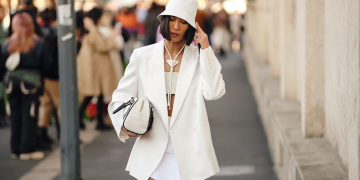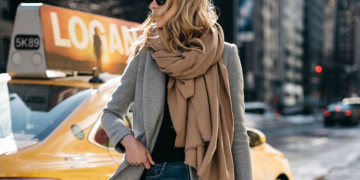In a scene that quickly goes viral, cousin Greg takes his date Bridget to the birthday party of Logan Roy, the billionaire founder and CEO of media conglomerate Waystar-Royco. By inviting a stranger into Logan’s private home, he grossly misreads the situation. But if Greg is rude – his date is rude.
By carrying a “ridiculously large” bag – designated by Tom Wambsgan as Greg’s tormentor and co-conspirator – Bridget immediately marked herself as an intruder in this unique world. himself as an intruder in this unique world. “What’s in it, anyway?” Tom asks mockingly. “Subway’s flat shoes? Her lunch pail? It’s huge. You can take it camping with you. You can slide it across the floor after you work at the bank.” Of course, the super-rich rarely need to carry anything on their own. But it’s not just the size of the problem. The distinctive plaid print is instantly recognizable – even without the accompanying logo. This is a bag with a price tag on the sleeve. It’s flashy and eye-catching, and everything Roys and their ilk aren’t – because, once your bank balance reaches billions, you won’t
For the past four seasons, Inheritance has given us a glimpse (albeit a fictional one) into the lifestyles of America’s richest people, and has shown how billionaires set themselves apart from swamp-standard multimillionaires. The show is known for wealth advisors advising on every detail and clothing designers crafting closets that truly reflect the 0.01%.
Shiv Roy can probably afford any couture dress she wants, but you’ll likely find her in a plain black polo neck, brown pantsuit or beige shirt (albeit made of the finest silk). There may be the odd pinstripe or check – or the occasional flash of color at social events – but for the most part, this is subdued rather than a standout style. Meanwhile, her brother Kendall loves Loro Piana, an Italian brand that specializes in understated pieces made from the finest fabrics, including a jacket that costs $25,000 (though you can get Kendall’s beloved cashmere baseball cap for $495). As costume designer Colleen Morris-Glennon of the TV series Industry explained to Vogue – another show that lets us hang out with the fictional super-rich – the richer you are, the harder it is to stand out from the crowd. “The last person you’d think of as a billionaire is a billionaire.”
It’s not just Succession that puts hidden luxury style in the spotlight. Cate Blanchett’s role in the recent film Tár may have been problematic, but her closet was perfect; a perfect mix of staple pieces from Margaret Howell, Max Mara, The Row and Dries van Noten. “I wanted to make clothes that no one would look at,” costume designer Bina Daigeler tells WWD. instead, Lydia Tár’s understated style has made her an unexpected fashion icon.
Then there’s Gwyneth Paltrow’s most recent and much-discussed courtroom style. During the eight-day trial – in which the actress was found not at fault for a skiing accident in 2016 – Paltrow wore an array of understated but luxurious earth-toned outfits, including a cream cashmere knit by Loro Piana, a a wool jacket by The Row in moss green, a double-breasted gray pantsuit, Prada boots, leather dress pants by Proenza Schouler and pieces from her own label, G Label by Goop. This is quiet luxury at its most powerful.
We show loyalty to our social group and distinguish ourselves from others through our clothing – Carolyn Mair
It may be making headlines now, but the concept of invisible wealth is far from new. “The term ‘conspicuous consumption’ was coined by Thorsten Weblen in his 1899 book, The Theory of the Leisure Class. ” Dr. Carolyn Mair, a fashion business consultant and author of fashion psychology, told the BBC Culture channel. Webron describes it as “the act of flaunting wealth to gain social status and prestige” and identifies those new to wealth as more likely to indulge in this behavior. “The idea is that if you’re used to having money, you don’t need to flaunt it,” Mayer said.
Fashion is a powerful communication tool that even the super-rich don’t give up using. “We show loyalty to our social group and distinguish ourselves from others through our clothing,” Mair says. “Like any language, unless you’re fluent in that language, you’re likely to miss, misunderstand or at least misinterpret the nuances. That’s the concept behind invisible wealth: buying understated products because of their quality, beauty and rarity, but not leaving the price tag (to use an analogy) so only those in an equally affluent position will recognize the monetary value of the item.” There is an inner circle, a semi-secret code for invisible luxury dressing – a sense of “if you know, you know.
But for the very privileged few, invisible wealth has become more than a lifestyle. It has percolated down the food chain and become the dominant aesthetic of the season. As New York Times chief fashion critic Vanessa Friedman recently pointed out, the Milan show saw a shift toward clothes that “don’t clamor, but whisper. Friedman describes the look as “the kind of clothes that don’t advertise their value in an obvious way,” but instead “rely on soft fabrics and strict lines – based on insider information rather than influential messages – to suggest value. -to suggest value.” Think streamlined silhouettes, luxurious materials and a palette of shadowy tones, and Max Mara called their collection “Camel Reign.
British Vogue described the trend as “more of a mood than anything else” and “essentially synonymous with elevated basics. Meanwhile, hashtags like #stealthluxe have racked up millions of views on Tik Tok, where fashion stylists analyze how to get “invisible wealth” for less.
Conscious Consumption
So what’s driving it? Some say it’s a response to the current economic turmoil, echoing a similar shift in fashion after the 2008 financial crisis. Lorna Hall, director of fashion intelligence at trend forecaster WGSN, believes there is some truth to this. “Although fashion can sometimes become insensitive, it is still keenly attuned to social dynamics,” she told BBC Culture. “Now just like in the last financial crisis, brands want to make the right noises. While large numbers of people are struggling to heat their homes, extreme displays of flaunting wealth seem to fall on deaf ears.”




























